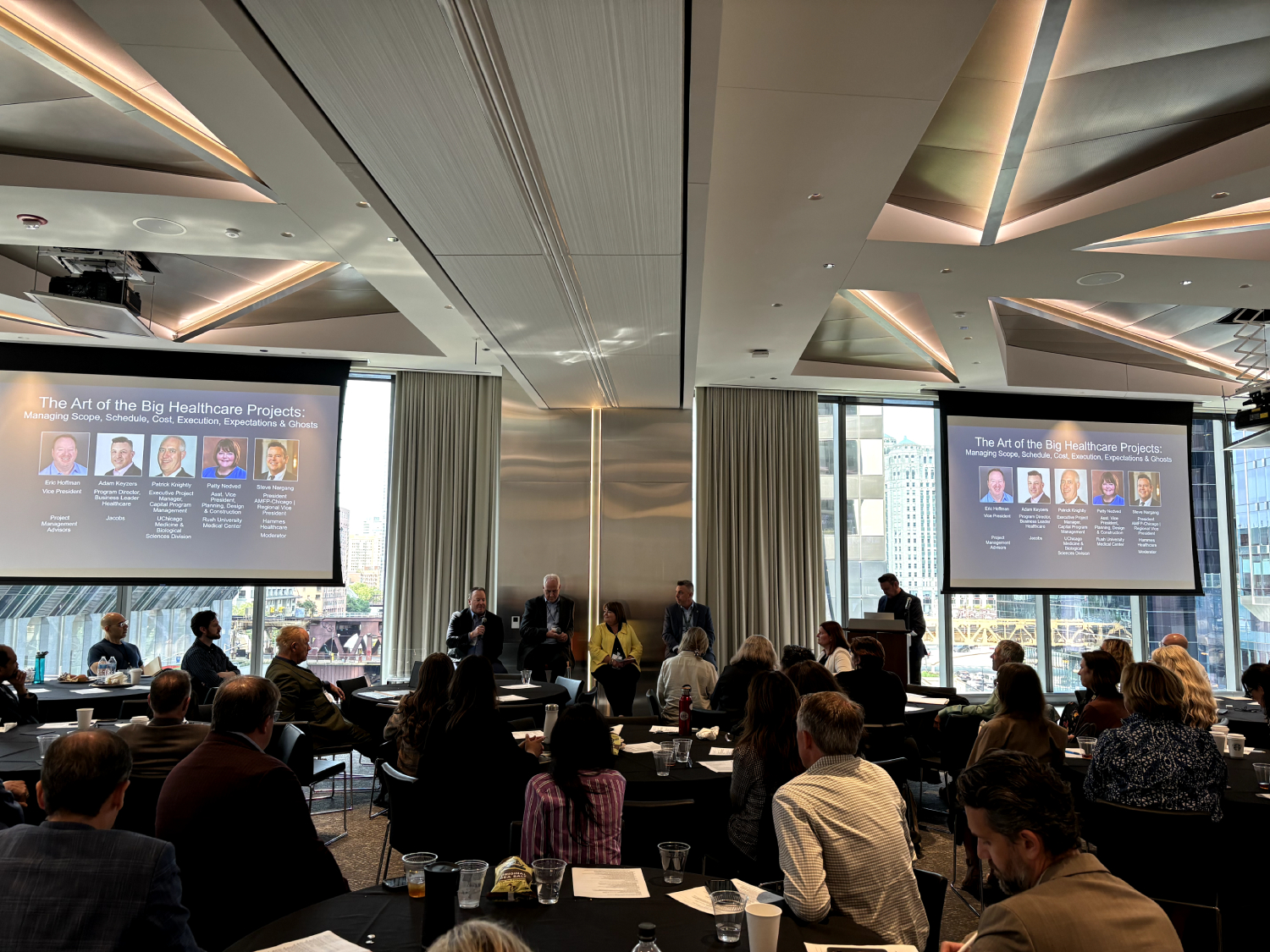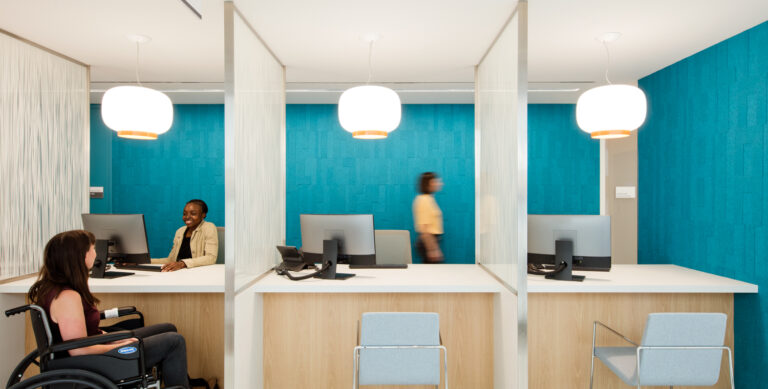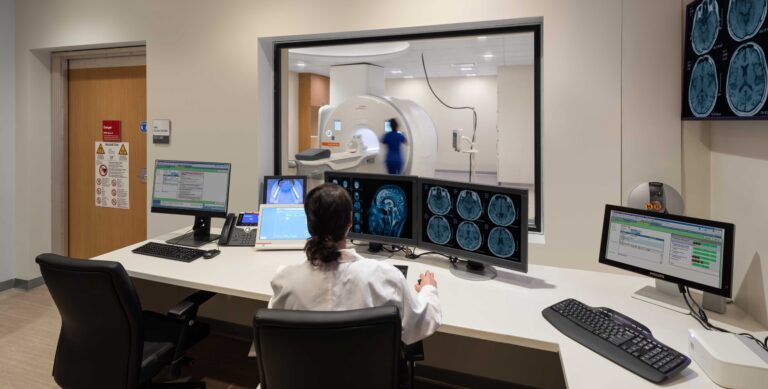PMA’s Eric Hoffman Speaks on the Challenges and Opportunities of Managing Large Hospital Projects

On September 10, 2024, PMA Vice President and Healthcare Sector Lead Eric Hoffman participated in a fascinating panel discussion at the 9th annual Association of Medical Facility Professionals (AMFP) Chicago Hospital, Outpatient Facilities & Medical Office Buildings Summit.
The session, titled ‘The Art of Big Healthcare,’ was moderated by AMFP’s Steve Nargang and included Hoffman speaking alongside fellow panelists Adam Keyzers of Jacobs, Patrick Knightly of UChicago Medicine and Patty Nedved of RUSH University Medical Center.
The summit looked at several forces affecting the healthcare space and how it impacts facilities construction, management and ongoing operations, particularly for large-scale health systems:
- Competition is fierce as more healthcare providers enter the market, many with non-traditional offerings that draw on technology platforms or retail services to deliver care directly to consumers, who are seeking healthcare services proactively and not just when they’re sick.
- As these new entrants chew at the edges of the entire healthcare ecosystem, traditional health systems are relying more on core services—emergency departments, intensive care units, labor and delivery, and medical surgery that can’t be performed in an outpatient environment—to differentiate and attract top talent and a broader base of consumers.
- Ambulatory care and outpatient settings are expected to grow for lower-acuity care patients, with health systems reassessing their real estate needs to provide for higher-acuity and specialty care, along with flexible space to evolve with the needs of consumer demand. Many health systems are making these decisions while also staring down deadlines for net-zero goals, reducing carbon emissions to meet organizational mandates.
State of Healthcare Facilities: On the Road to Recovery
The Covid-19 pandemic had an obvious and lasting effect on global health, and it also sent a shockwave to health system operations and investments. While resources were diverted to address the immediate health issues associated with the pandemic, health systems soon found themselves addressing staffing shortages and a lack of investment.
While many health systems weathered the storm, they did so with tightened finances and rising interest rates that deferred borrowing for major projects. In the past year, the workforce stabilized, inflation cooled, and strategic capital investments are once again on the table. But the lack of ongoing capital investment has resulted in aging and outdated facilities, with the average not-for-profit healthcare building being about 12.7 years old, as of 2022, according to Moody’s Investor Services.
Many large-scale health systems are starting the work of updating their facilities, considering new construction and modernization projects that will help them expand their capabilities and relevance in an increasingly competitive market. But these projects come with their own opportunities and challenges, as Eric Hoffman and others discussed.
Managing Large-Scale Projects: Coordination is Key
During “The Art of Big Healthcare” panel, the discussion centered around ways diverse project teams can best manage scope, schedule, cost, execution and expectations throughout the life cycle of a large healthcare building project. Defined by the panelists as a healthcare project with a budget of over $1 billion and a timeline of five or more years, large healthcare projects require a significantly deeper level of coordination than the typical medical construction job. Hoffman noted that, given the longer timeline of these larger hospital projects, having the right team in place from as early as possible is essential:
“Time, and the influences to the project that evolve over time, are some of the biggest considerations for any large hospital building,” he said. “Just think about all that can change in five years — there are projects that started pre-COVID that are still wrapping up! Funding methods evolve, crucial team members move on to new roles and companies, and new technologies are developed. Involving the right people early on and developing a change management plan is key to success on a large project.”
Hoffman frequently recommends an owner change committee be part of the project team to manage inevitable changes and help balance near-term with long-term operational costs.
Ensuring Community Support
Given the long runways for large healthcare projects, Hoffman and the other panelists agreed that it’s essential for the project teams to be thoughtfully engaged with community stakeholders – such as aldermen, school administrators, local businesses and neighbors – around the construction site throughout the course of the project, as this can help to prevent negative community disruptions such as noise, traffic jams or even out-of-place design choices. Hoffman also noted that engaging building owners early and often is also an essential component to success in these projects.
“Ongoing collaboration between project teams, end users, owners and local stakeholders provides the pathway to producing a better product faster,” said Hoffman.
This support is also important as more people have greater choice in where they experience healthcare, from their comfort of their own home via telehealth appointments, to retail-first locations embedded within existing pharmacies or even department stores. If the community is up to date on construction developments and long-term system plans, they will also be more informed about the services available to them as healthcare consumers.
Expect the Unexpected
Another major discussion point for the panel was planning for disruptions and changes in staffing during longer-term projects. The panelists agreed that having a plan in place for governance and change management from the beginning of the project were vitally important to ensure minimal problems when, for example, a key team member leaves or is indisposed.
“The theme here is that you know it’s going to happen, so you need to plan for it,” said Hoffman. “You’re going to lose people, it’s an unavoidable part of the process. My advice is to have a robust onboarding process for new leaders to follow as they come on, and to appoint a dedicated communications person internally who can be a part of that process. That person can help to make sure that decisions are communicated appropriately and ensure that everyone involved feels heard and understood.”
Hoffman’s panel capped a day-long examination of the emerging forces affecting the healthcare space, including everything from healthcare acquisitions and ambulatory care migration to the ways new technology can help improve safety and when adaptive reuse makes sense for healthcare facilities. As the leader of PMA’s national healthcare sector, Hoffman has more than 30 years of experience in construction, project management, design and facilities operations on large hospitals and healthcare systems.
To learn more about PMA’s healthcare practice, click here or visit: https://www.pmainc.com/sectors/healthcare/
How Tariffs and Labor Shortages Will Thwart Housing Production
New federal policies have already impacted deal flow. What's next?





